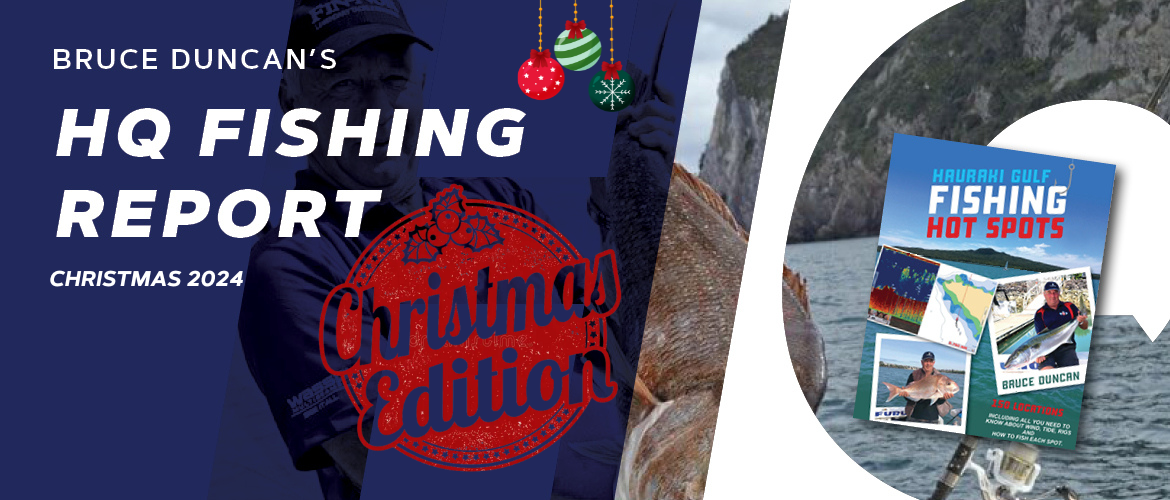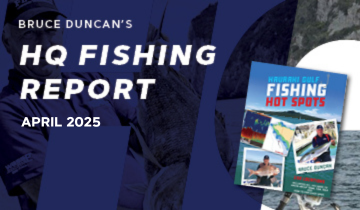First, let me wish you all a safe, happy, Merry Christmas.
The best thing about being on a holiday break is you are not under any pressure with fewer time constraints, allowing you to have a way more relaxed time on the water, and time on the water is the way you learn.
Quality family time is so important. Taking time out with the kids gives them the building blocks of life. Out on the water, they learn about tides and weather—all the fundamentals of life they won’t get if their face is buried in an iPad. If you go ashore, send the kids on a scavenger hunt. First, back to the boat with ten pieces of rubbish, gets a treat. Now they see how important it is not to drop anything over the side.
Kids need to want to go out rather than being dragged out on the boat to spend time with their parents, and this starts with keeping their minds and bodies fully occupied. Catching fresh bait is the best way to set them on a lifetime of fishing. Nothing gets them more excited and prouder when you show them how to rig their freshly caught baitfish, cast it out, and it catches a big fish. That’s where it all begins: the challenge and passion to be out on the water to catch a bigger fish than Dad never ceases. None of us can remember the first football we kicked, but every one of us remembers our first fish, and that’s where the dreams start.
If your mum or the kids are prone to feeling a bit seasick at times, try sucking on a hard sweet or chewing gum; the action of jaw movement helps to balance the inner ear.

From now on through to the end of January, catching fish can often be the hardest time of the year. Once spawning is over, the fish go on a bit of a feeding frenzy to regain body fat and condition. If the fishing’s slow, take time out to try something or somewhere different to the normal spots; it’s the perfect time to build up that mental database and expand your knowledge and skills. You are never going to know if you don’t give it a go.
With no time constraints over the holidays, you only need a few fish for the table each day, so take the opportunity to spend time learning. Most people have little idea of what they see on their sounder. There is more to it rather than just looking at fish marks. Why are there fish here? “Habitat is where it’s at. “In other words, there must be a food source, so what is it? Looking at your sounder, note the actual bottom type. Is it just dead flat mud/sand, or has it some isolated rocks and foul? What are fish marks? This can depend a bit on the depth of water, but importantly, knowing the bottom type, we all know reef structure has marine growth the home of crabs, limpets, snails and baitfish. Hence, it supports on and around the structure, Snapper, John Dory and Kingfish. Fishing in areas of flat, featureless sand, the snapper gurnard, etc, will be feeding on crabs’ shellfish and bait fish. With no structure to hold fish, they will be mostly spread out, simply grazing as and when they feel the need. For every fish I gut, I check to see what they are feeding on. What they eat often determines how they will take the bait; when there are small taps on the line, more often than not, they are small fish. If they are eating pipis or cockles, simply they just pluck one out of the sand and then crunch it up, spitting out most of the hard shell. When they are feeding on shellfish, I will cut down the size of the bait so when I feel the taps, I know the barb of the hook is in their mouths, and it’s time to strike.
Spend as much time as you can just looking and learning about your habitat on the slack water when the fish aren’t biting or on the way home. Check out the shoreline for signs of outlying rock or kelp beds. If the bottom is flat and sandy, idle between 4 to 6 knots, and look for changes in bottom density fish marks and any fish sign in mid-water. If you come across any isolated rocks or low foul, mark them as they always hold fish and are more valuable than Homer Simpson’s doughnuts.
Fish marks show up as either single blue dots or blotches of red, either just off or hard down on the bottom. Personally, I run a zig-zag course into the wind and tide; this stops the boat rolling around, allowing me to focus on the sounder, giving me a far greater picture of where and how many fish are in the area. In summer, you will come across schools of snapper showing as a long red blob, but in winter, you will generally see intermittent fish marks. Don’t be fooled in thinking the size of the red masses and blotches have to be just bait fish, test it out by dropping a baited sabiki flasher rig.
Looking after your catch in the hot summer sun is critical. Snapper is between $49 to $55 a kilo where as the best steak is mostly around the $40 mark and you don’t leave your steak in the car for hours out in the hot sun. I have a bucket filled with salt water with a two-litre frozen water bottle. Once a fish is landed and iki’d it’s then put in the ice water to chill down, given half an hour then transferred it onto ice in the chilly bin. Small frozen drink bottles cost nothing and are ideal to pack around fish.
While out at sea, I gut and wash the fish. Back home, I put them in the fridge to chill until I need them. If you fillet them all straight away, you lose a lot of the moisture and flavour from the fillet. Fillet only what you need to eat about an hour before cooking that night. Fish that have chilled overnight are so much easier to filet, skin, and bone. The flesh is firm, and with no moisture loss, the intensity of the flavour is amazing.
I know a lot of fishos use mostly ledger /flasher rigs. Don’t get me wrong, they work well, but I seldom use one as I prefer using a stray line rig. Simply put, the smallest sinker to just get the bait down and tie on a 7 or 8 /0 octopus hook; yep, no trance! When the bait has been cast well away from the boat, just allow the weight of the sinker and bait to take the line off the spool; lifting the rod to take out the line only creates a belly in the line, preventing you from feeling the bites. No trace, I hear you cry. Well, if you are in touch with the bait and strike at the right time, you jaw hook the fish, In this style of fishing, over time, you will learn more about the way and how fish feed while teaching you rod skills. Re-curve hooks, such as those on flasher rigs, can also be deadly when the moon phase or tides are not in your favour or the fish are soft on the bite. Just keep an eye out at the rod tip and note any line movement, as you don’t need to strike and spook the fish. A recurve hook is designed to roll into the corner of the mouth and is ideal when using a big slab of fresh bait. Let them chew it down, and as they move off, it will self-hook, an ideal hook when using fresh bait.
I can honestly say I would only get busted off maybe 3-6 times a year, which I put down to being a slack lazy bugger that knows every time you go out to cut back the line and re-rig it, merely the friction of the sinker over time damages the line let alone the damage is done when the hard raspy tail bangs away on the line when doing a run.
I know it’s stating the obvious, and I don’t want to tell you how to suck eggs but carry a spare tank of fuel on calm hot sunny days, be it dragging lures or just checking out the bottom for new spots. You go through more fuel than the average day out. Lesson learnt the hard way, having been engrossed for nearly an hour marking an isolated rock I had come across [ not marked on the chart]. Then I mooched around the area for a while, noting the bottom type where the fish were holding at that time of the tide. At home, I fired up the motor to flush it; it fired, then coughed, spluttered and died, totally out of fuel. Scary stuff. Had it been a rough, choppy day, I would run out well before the boat ramp.
It’s the same every summer: “a case of the dreaded ramp rage. “To be fair, I am a quiet, mild, easy going, kind-hearted bloke who loves little furry animals and is kind to old ladies, but I will admit I get grumpy when I watch and wait for people to unload the car take off tie downs while blocking the ramp, all could have been done while waiting in the queue for their turn to launch. I look with great big green envy eyes when I see a new Haines Hunter Overlander puttering around the plonkers, holding up the ramp and self-launching without getting their feet wet.
Well, team, that’s all for me this year. I hope that I have been of some help to you and your catch rate. If you get the chance, I would love to get some feedback from around the country.
Now, don’t forget to take enough for a feed and give the rest a chance to breed.








